Horror and pornography are inherently linked. For many reasons. It’s not just about horror movies often succumbing to the nudity card in order to tantalize audiences. It isn’t just about both being often banned and censored, though that is a symptom of a number of interesting social questions that is raised over and over again in generations of filmgoers. No, horror and porn are linked for many reasons because they have held similar places in popular culture and filmmaking throughout the years. In the movie X, explaining and dissecting the film means getting at the root of this relationship.
So strap in. Spoilers abound. Let’s get into what I think will become a modern classic in the horror genre.
The Movie X (2022) Synopsis
X is a 2022 horror movie written and directed by Ti West and starring Mia Goth, Jenna Ortega, Brittany Snow, Kid Cudi, Martin Henderson, and Owen Campbell.
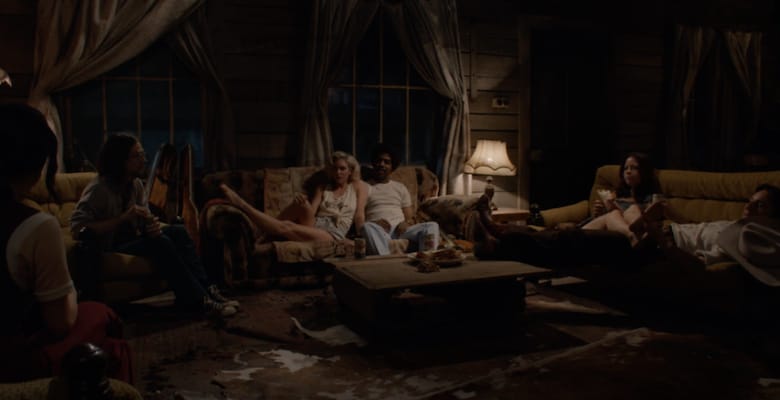
In X, we find Mia Goth’s Maxine pining to be a movie star. Set in rural Texas in 1979, the porn industry was attracting young actresses at the time with the idea of making it big. This leads her producer-boyfriend Wayne and the rest of a low-budget porn crew to take off on-location to a cabin in the woods, being rented by an old farmer, Howard, played by Stephen Ure.
As you would expect in such horror movies sometimes coined hillbilly horror, the local couple don’t take kindly to their home being used for such filth. And one-by-one, they begin the slaughter.
What X does so well is what other films such as Cabin in the Woods, Behind the Mask: The Rise of Leslie Vernon, and other modern horror have done before. And that is self-awareness. It gets meta.
Like many horror movies that verge into “meta” commentary, it can be helpful to look at specific instances in which the film is paying an homage to a classic, but also how the filmmakers are delineating in order to create an interesting statement. Throughout the movie X, I explained what I was seeing often through understanding how it was clearly setting itself up as a Texas Chainsaw Massacre clone, only different.
Over and over again I saw shots, frames, camera angles, scenes, and even color choices that mimicked 1974’s Texas Chainsaw Massacre. Setting the year of X in 1979 meant that Texas Chainsaw Massacre at that point was clearly becoming a phenomenon among budding genre filmmakers such as RJ. It was redefining low budget filmmaking in a way so that even porn films were being influenced.
Time and again I saw Texas Chainsaw Massacre. From the van and the gas station in the beginning.

To the location they find themselves in.
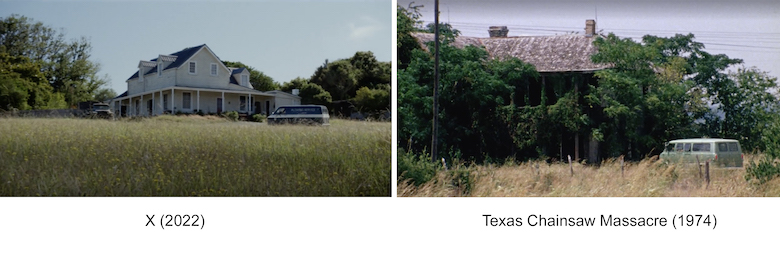
To specific scenes and camera angles.
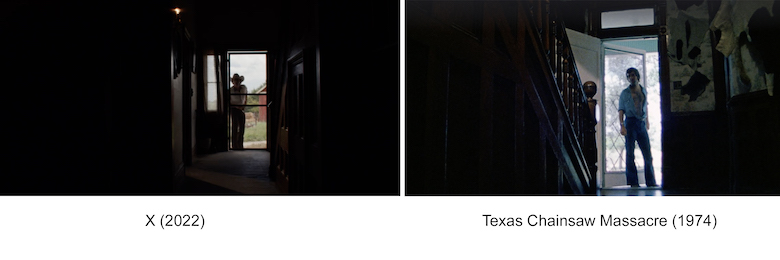
Looking at it in this way, what I want to point out is the juxtaposition of two scenes that happen late in their respective films. Both can be seen as this final girl, the outsider, getting a glimpse of what her captor’s lives are like… witnessing the family life of the deranged rural folks she has found herself a part of. In the case of Texas Chainsaw Massacre, Sally is invited to dinner. In the case of the movie X, Maxine is invited to hear the lovemaking of Howard and Pearl.
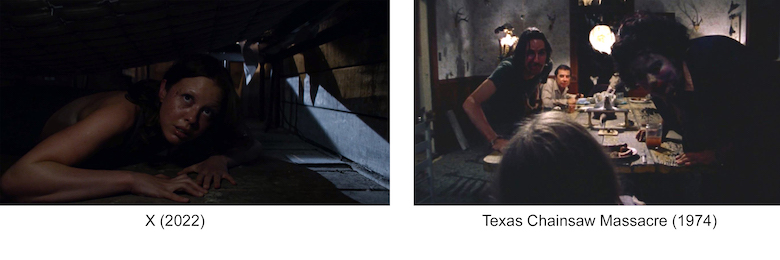
What I think this in particular does is shine a light on what Ti West is doing. While Texas Chainsaw Massacre was interested in violence and cannibalism (with gender and sex more muted undertones), X is much more interested in sexuality and youth in the forefront. So much has been written about how Texas Chainsaw Massacre is about rural decay, gender nonconformity or similarly being unsexed, family and queerness, subverting gothic horror, and so on and so forth. X takes those subtexts and runs wild with them.
There is a lot going on with Texas Chainsaw Massacre. And so, too, is there a lot going on with Ti West’s X.
X Explained as Meta About Horror and Porn
Horror and pornography live in the fringes of cinema. They are subversive in nature. Before the 1970s they were mostly considered a lower art form, or not an art form at all. Together they had peep shows and grindhouse cinema as a mechanism for allowing those who wanted those types of films to get them, since VHS and the internet was not a thing yet. (Which happens to be alluded to in X.)
Things were changing in the 1970s. In 1969 Andy Warhol’s Blue Movie was the first adult erotic film to receive a wide theatrical release. After that came porn movies that were considered “mainstream” such as Deep Throat and The Devil in Miss Jones. With these, the idea that “pornography” and “art” were not so diametrically opposed. Of course the Europeans and many people knew this already, but the filmmakers were often slow to understand. The culture was shifting so that experimentation of the filmmaking art form could happen with the porn industry as much as it was happening in other genres.
— FOUNDATIONS OF HORROR —
Further explore these subgenres and tropes. more>>
#Sex & gender horror | #Hillbilly Horrors | Slasher horror | Foreign Locations are Scary

In horror, the same thing was happening. While filmmakers like Hitchcock and Polanski came before and began to “legitimize” horror films with Psycho (1960) and Rosemary’s Baby (1968), it was the 1970s that gave us The Exorcist (1973), Carrie (1976), and so much more. Before many people thought of only creature features and B-movies as representative of the horror genre, but the tides were turning.
In X, we see this juxtaposition between horror and porn. Before that time there were just the “Waynes” of the horror and porn industries. They did not look for innovation or artistry. Add some scares or add some sex and that was good enough for audiences. In response to Wayne marveling at the quality of the porn film they are making, “People are going to want to see what I just saw in there!” RJ replies:
That’s because I’m not treating it like pornography, but as cinema. That’s what these other adult films are lacking.
Many would argue that both adult films and horror should not be considered separate from what is deemed cinema. It is cinema, or at least it can be. In any case, this is the mindset that was setting in at the time. While it was not considered high art before, new auteurs were changing things.
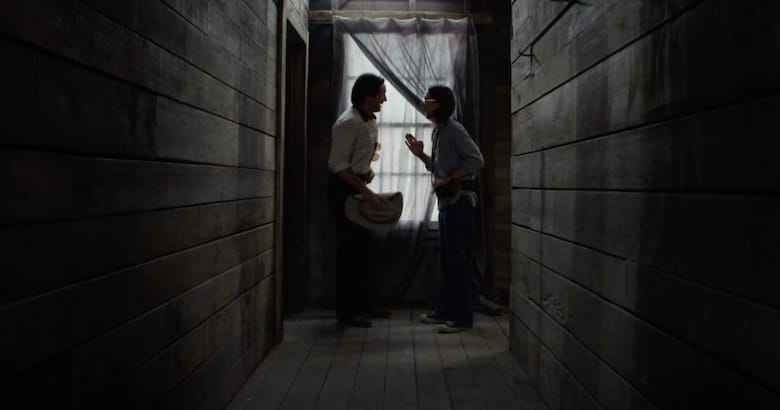
In horror in the 1970s came movies like Texas Chainsaw Massacre and Wes Craven’s The Hills Have Eyes, examples of both hillbilly horror (a group of young people traveling, confronting deranged rural folk) that were done by innovative auteurs like Tobe Hooper and Wes Craven making them more cinematic and experimental than they ever had been before. Ti West’s X is using a fictional porn movie to both comment on that time in the horror genre and set a horror movie in that time. Much in the same way that The Cabin in the Woods was set in a traditional horror movie scenario but was also commenting on the tropes themselves.
And like Cabin in the Woods, repeated viewings and time will likely be very kind to this immensely complex film.
X Explained as a Dissection of Youth and Aging
Mia Goth plays the role of both Maxine and Pearl. And right there we get at the heart of what Ti West is trying to accomplish with this movie.
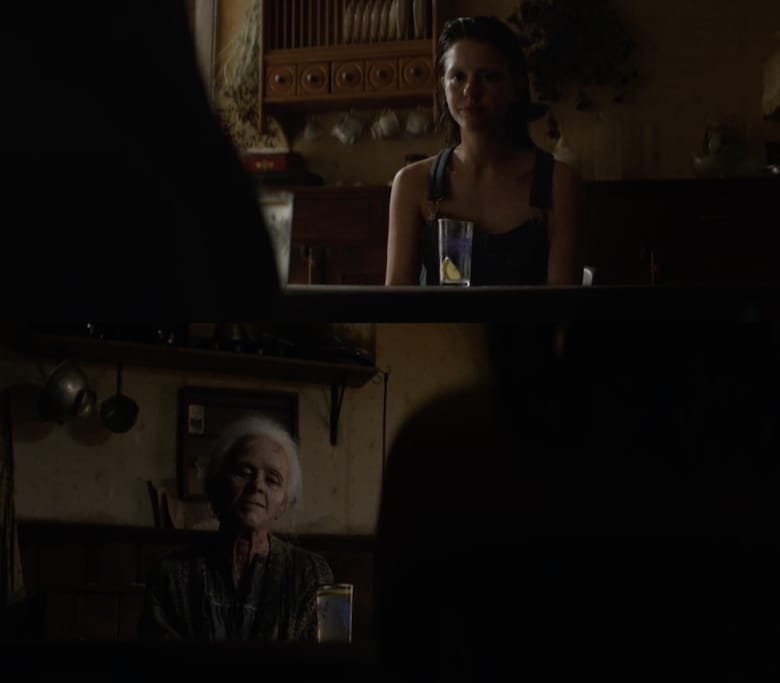
Maxine is deathly concerned about growing old, losing her beauty, losing her X-factor. Pearl is obsessed with the beauty and sex she once had when she was young. They are two sides of a mirror, staring at what will become and what once was.
It is possible to connect this idea to all the other things that are going on in the film: politically, culturally. Rather than Howard and Pearl, these two old farmers, merely being ultra-conservative and seeking religious punishment for these sinful pornographers (which there is some of that in the TV preacher featured in the film), ultimately the message is one of resentment and jealousy. Rural religious conservatives don’t hate sexy young people because of the sex they have; they hate them because they are having the sex that they can no longer have.
There are a number of details that hit home this idea of resentment between Maxine and Pearl. Perhaps the most telling is how the ending of X plays out. It comes down to the two confronting each other.
Maxine yells “Stop fucking staring at me!” as she points a gun at Pearl (the embodiment of her body some day, an old woman). What is fascinating is that this is exactly what Pearl was doing earlier in the film. Not just staring at Maxine. Staring at her younger self in a photo.
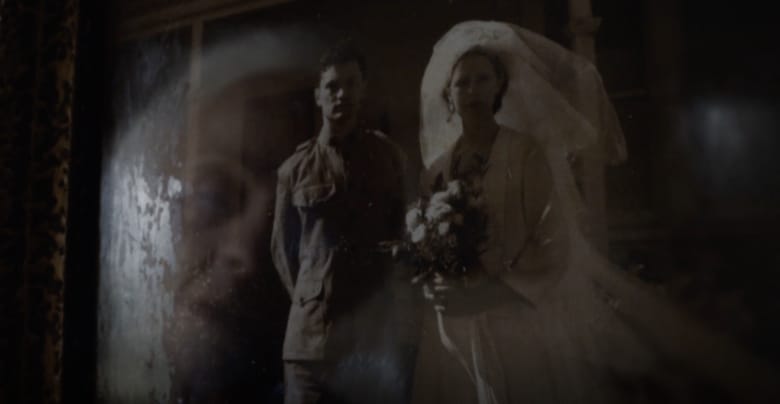
Just after she says this, Maxine shoots but her gun does not fire. Pearl has an opportunity and bends down, wielding a shotgun. As she fires, she misses and shatters a mirror instead.
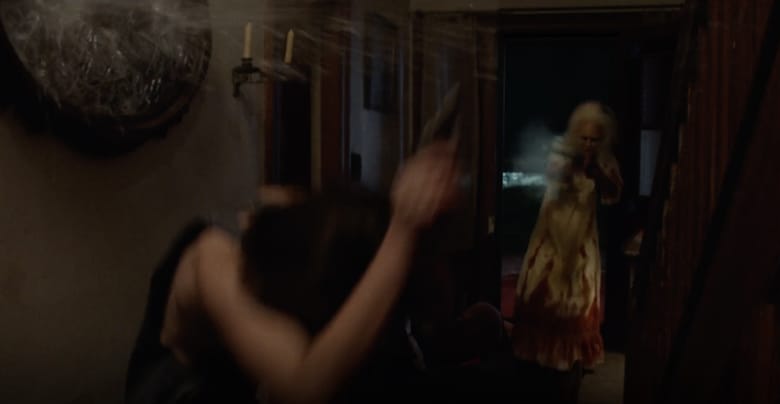
That was a conscious choice by the filmmakers, and an interesting one. Shooting the mirror symbolizes the shattering of this ugly fear that Maxine stares at when she looks in the mirror. She was staring at the mirror at the beginning of the movie, telling herself that she was a star. Convincing herself that her beauty and youth would not fade.
Shattering the mirror is breaking the image of herself getting old and no longer having the X-factor that makes her alluring. Looking in the rearview mirror in the car and backing over the head of Pearl, shattering her old face, is a symbolic crushing of that fear. And driving forward into the night.
In the end I expect Ti West’s X to be a movie that is returned to again and again over the years as a fascinating exploration of the horror genre. This is despite some who may only see the superficial blood and boobs of it all. Watch it again. There is a lot going on.
Or even better. See the origin! Ti West is following up X with his next movie: Pearl!
Last Updated on August 24, 2022.

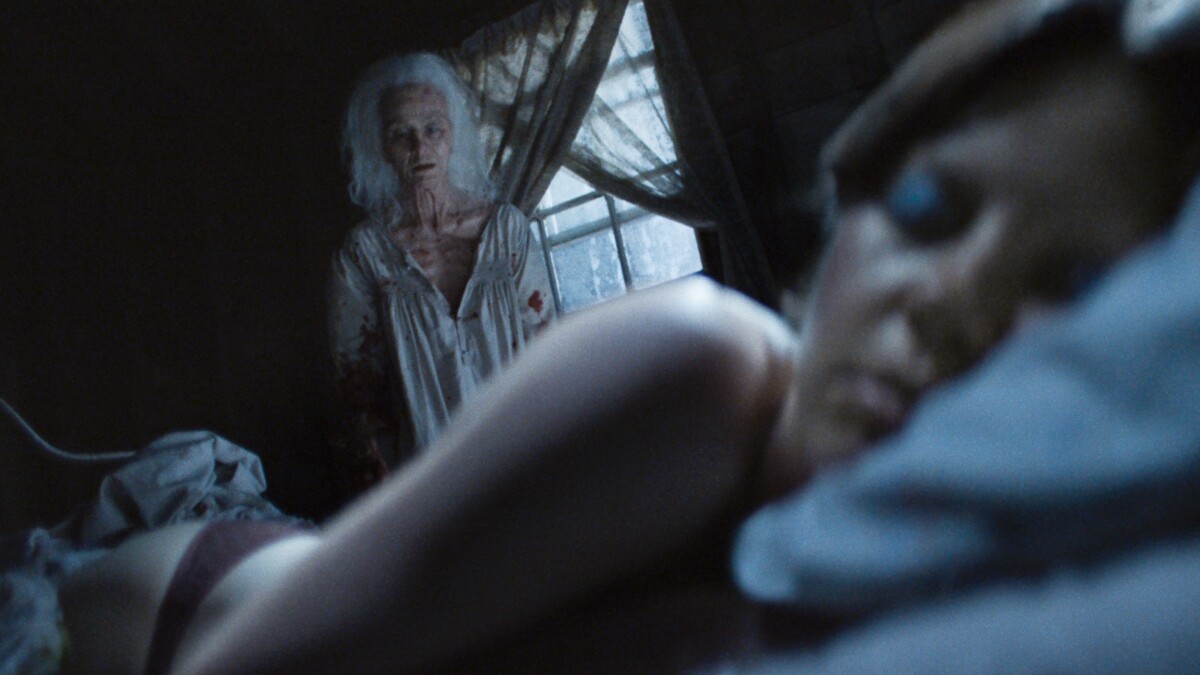
2 Comments